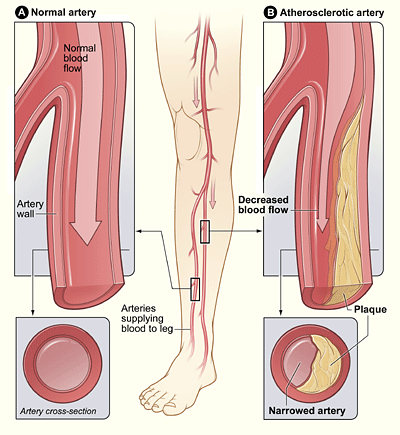Peripheral Artery Disease (PAD)

Peripheral Artery Disease (PAD) is a build up of plaque in the arteries in your legs. Plaque is made of fat, cholesterol, calcium, fibrous tissue, and other substances in the blood. Over time, the plaque hardens and the artery size becomes narrower, limiting the blood flow.
Approximately 8.5 million people age 40 and older in the United States have PAD.
PAD Risk Factors
- Smoking (or a history of smoking) is the main risk factor for PAD.
- Age is a risk factor because plaque builds up as you age
- Diabetes
- High Blood Pressure
- High Cholesterol
- Coronary Artery Disease
- Metabolic Syndrome
PAD Prevention
- Be physically active
- Discuss screening with your physician
- Heart Healthy Diet
- If you smoke, quit. You can discuss options that can be beneficial with your physician
- If you are overweight, create a reasonable weight loss plan
PAD Screening
Many people who have PAD do not have symptoms. If you do not have symptoms, ask your doctor if you should be screened if:
- You are over 70 years of age
- You are 50 or older and have Diabetes or a history of smoking
- You are younger than 50 and diabetes and one or more risk factors
PAD Symptoms
People who are symptomatic may have pain when climbing stairs, which may include numbness, aching, or heaviness in the leg muscles. Some people experience cramping in the leg, buttocks, thighs, calves, and feet. These symptoms may become better after resting. Other signs and symptoms of PAD include:
- Weak or absent pulses in the legs or feet
- Sores or wounds on the toes, feet, or legs that heal slowly, poorly, or not at all
- A pale or bluish color to the skin
- A lower temperature in one leg compared to the other leg
- Poor nail growth on the toes and decreased hair growth on the legs
- Erectile dysfunction, especially among men who have diabetes
PAD Diagnosis
PAD is diagnosed by physical exam and additional testing such as ankle brachial index testing, ultrasound, MRI, or an arteriogram. For treatment, you may be referred to a Vascular Specialist or Cardiologist.
PAD Treatments
- Heart healthy lifestyle changes
- Your doctor may recommend bypass grafting surgery if blood flow in your limbs is blocked or nearly blocked
- Your doctor may recommend angioplasty or insertion of a stent to restore blood flow through a narrowed or blocked artery.
If you have peripheral artery disease (PAD), you’re more likely to also have ischemic heart disease, heart attack, stroke, and transient ischemic attack ("mini-stroke"). However, you can take steps to treat and control PAD and lower your risk for these other conditions.
Talk with your doctor about taking part in a supervised exercise program. This type of program has been shown to reduce PAD symptoms.
Check your feet and toes regularly for sores or possible infections. Wear comfortable shoes that fit well. Maintain good foot hygiene and have professional medical treatment for corns, bunions, or calluses.